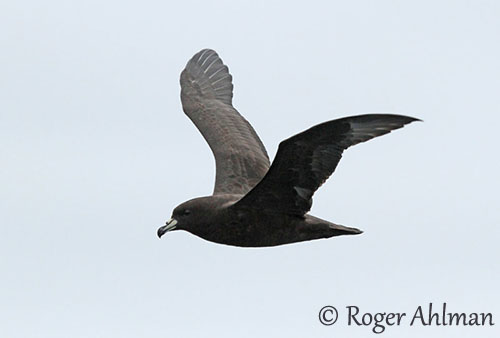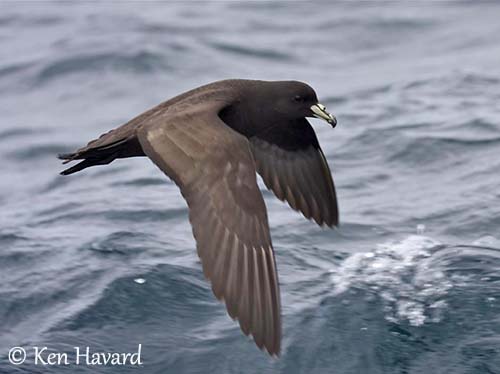
Black Petrel or Parkinson’s Petrel
Procellaria parkinsoni
Procallariiformes Order – Procellariidae Family
INTRODUCTION:
The first illustration of the Black Petrel was made by Sydney Parkinson during the James Cook’s first trip to the Pacific in 1768. This species was first seen off the New Zealand coasts. French, English and scientific names pay tribute to this artist.
This petrel is the smallest species of genus Procellaria. Often solitary at sea, it may feed in small groups associated with marine mammals.
The small population appears currently stable, but the species has restricted breeding range and is threatened by the usual introduced predators.
DESCRIPTION OF THE BIRD:
Biometrics:
Length: 46 cm
Wingspan: 112-123 cm
Weight: 700 g
The adult has sooty-black plumage with slightly darker head and neck.
On the underwing, coverts and bases of primary flight feathers are paler and greyer.
The bill is pale yellowish with greyer culmen and tip. The eyes are dark brown. Legs and webbed feet are blackish.
Both sexes are similar, although the male has slightly larger wings and bill than female.
The juvenile resembles adults with less yellowish bill, mostly tinged greyish, bluish or pink.
The Black Petrel is smaller and more slender than the White-chinned Petrel (P. aequinoctialis), and very similar to the Westland Petrel (P. westlandica), although the Black Petrel has slightly smaller bill and narrower wings.
Fr: Puffin de Parkinson
Maori: Taiko
Ang: Black Petrel – Parkinson’s Petrel
All: Schwarzsturmvogel
Esp: Pardela de Parkinson
Ita: Procellaria nera
Nd: Zwarte Stormvogel
Sd: Mindre sotpetrell
Photographers:
Roger Ahlman
Pbase Galleries Peru and Ecuador
Ken Havard
My Bird Gallery & Flickr gallery 1 & Flickr gallery 2
Text by Nicole Bouglouan
Sources:
HANDBOOK OF THE BIRDS OF THE WORLD vol 1 by Josep del Hoyo-Andrew Elliot-Jordi Sargatal - Lynx Edicions - ISBN: 8487334105
BirdLife International (BirdLife International)
New Zealand birds and birding (Narena Olliver)
New Zealand bird status between 2008 and 2012
Te Ara – The Encyclopedia of New Zealand
Tiritiri Matangi Open Sanctuary
Ocean Wanderers "Ride the Wave"
Wikipedia, the free encyclopaedia
Page family Procellariidae
Summary cards

RANGE:
The Black Petrel breeds on Great Barrier Island and Little Barrier Island in the Hauraki Gulf, Auckland, off NE North Island, New Zealand.
It spends the breeding season around New Zealand, eastern Australia and the Pacific islands. After breeding, it migrates to the South American waters and can be seen off Ecuador. But this species is also reported off Panama, Costa Rica, Guatemala, Mexico and Galapagos Islands.
HABITAT:
The Black Petrel is marine and pelagic. During the breeding season, it excavates the nesting burrow in podocarp and broadleaf forests, usually above 500 metres. But it also breeds in tall forest and alpine tussock grassland, up to 1200 metres of elevation on the mainland.
CALLS AND SONGS: SOUNDS BY XENO-CANTO
The Black Petrel is usually silent at sea, but it is more vocal when it approaches the colonies at night. It gives several common “clack” which are far-carrying calls, from the ground or in the burrow. During aggressive encounters, it utters high-pitched throaty squawks, also used when the bird is threatened.
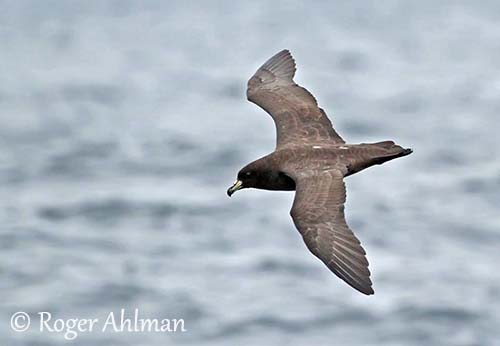
BEHAVIOUR IN THE WILD:
The Black Petrel forages and feeds mainly at night. It feeds primarily on bioluminescent squid, Ommastrephes bartrami and Histioteuthis. It also takes some fish and crustaceans, and other small marine preys.
It catches preys by surface-seizing and surface-diving, and these actions are very rapid. However, it can perform pursuit-plunge during up to 20 seconds.
It feeds alone or in loose flocks and mainly at night. It can be seen around the fishing boats where it takes some debris. Outside the breeding season, it often forages with cetaceans which usually lead the preys close to the surface.
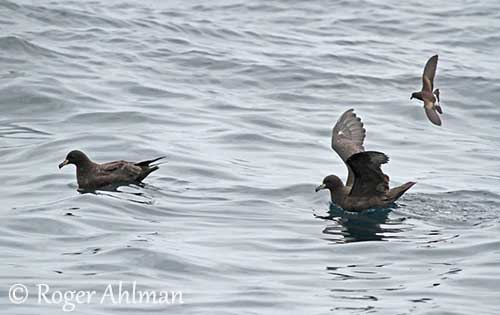
The Black Petrel breeds in colonies and nests in burrows. The pairs are monogamous with long-term pair-bonds. They can stay in the burrow during the daylight, but they usually visit the colonies at night, arriving after dark and depart before dawn, in order to avoid predators and piracy from other seabirds.
The Black Petrel becomes vocal on the ground and at the colony. The male attracts females to the nest-site by giving repeated “clack” calls. The female gives an “aerial call” while approaching the colony or flying above the site. Male and female give “crooning” calls while bonding inside the burrow, or with the chick.
The sexual activities between mates take place inside the burrow. They commonly perform “billing” while oil is dribbling down the beak. Both mates also engage in mutual preening.
They are territorial around the nest entrance.
After this period spent on land while preparing the burrow and the territory, the pair goes back to sea to regain weight before the laying and the long incubation period.
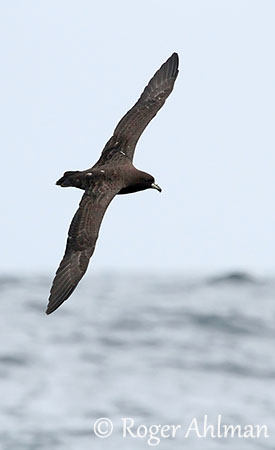
The Black Petrel is migratory and moves E over C Pacific to the W coasts of Central and South America.
Petrels are good fliers, using periods of flapping interspersed with glides on stiff wings.
REPRODUCTION OF THIS SPECIES:
The breeding season starts in October, with petrels preparing the nesting period. The laying occurs between mid-November and late January. The season lasts until July.
The Black Petrel nests in colonies. They excavate the burrow of 1-3 metres long, but they also may nest in cavities, among tree roots or in hollow logs. There is a sparse lining in the nest chamber.
The female lays a single white egg. The long incubation period lasts 56-57 days. Both sexes share the incubation with stints of 8-17 days.
At hatching, the chick is covered with black down. It is fed by parents by regurgitation every 2-3 nights. It fledges between 95 and 120 days after hatching. Both parents feed it until it fledges.
The young bird will return to the colony at 4-6 years old, and it will breed when 5-7 years old.
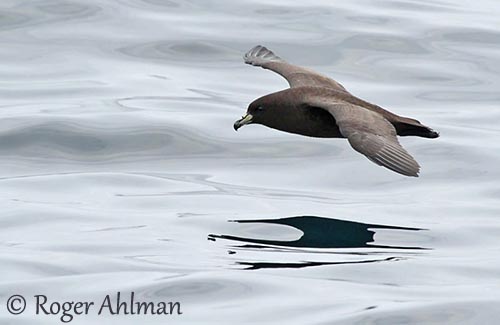
PROTECTION / THREATS / STATUS:
The Black Petrel has been extirpated from mainland New Zealand by introduced mammalian predators. The colony of the Little Barrier Island is legally protected, and this predator-free island has restricted access. However, these predators are present on Great Barrier Island at the main colony on Mount Hobson summit area.
The Black Petrel has been caught by fishers, both commercial and recreational, while foraging around the fishing boats in New Zealand waters. The fluctuations of El Niño also affect these birds during their migration to the E Pacific, off Ecuador and Peru. They are also caught on longlines in this area.
The Black Petrel is evaluated as Nationally Vulnerable in New Zealand, and globally classified as Vulnerable with a global population of about 5,000 individuals, including the non-breeding birds, roughly equivalent to 3,300 mature individuals. However, a slow increase is suspected on Little Barrier Island.
